MERCEDES-BENZ CLK320 2001 A208 Owner's Manual
Manufacturer: MERCEDES-BENZ, Model Year: 2001, Model line: CLK320, Model: MERCEDES-BENZ CLK320 2001 A208Pages: 325, PDF Size: 8.12 MB
Page 171 of 325

168 Ski sack
Te ch n ica l
data Instruments
and controlsOperationDrivingInstrument
cluster displayPractical hints Car care Index
Ski sack (optional)
Unfolding and loading
1. Fold armrest (1) down.
2. Swing cover (2) down.
3. Pull ski sack into passenger compartment and
unfold.4. Swing f lap (3) in trunk up (a magnet will hold f lap
in its top position).
5. Slide skis into ski sack.
2
1
P91.10-2056-26
Wa r n i n g !
The ski sack is designed for up to two pairs of skis.
Do not load the ski sack with other objects.Always fasten the ski sack securely. In an accident,
an unfastened ski sack can cause injury to vehicle
occupants.
P91.10-2061.26
3
Page 172 of 325
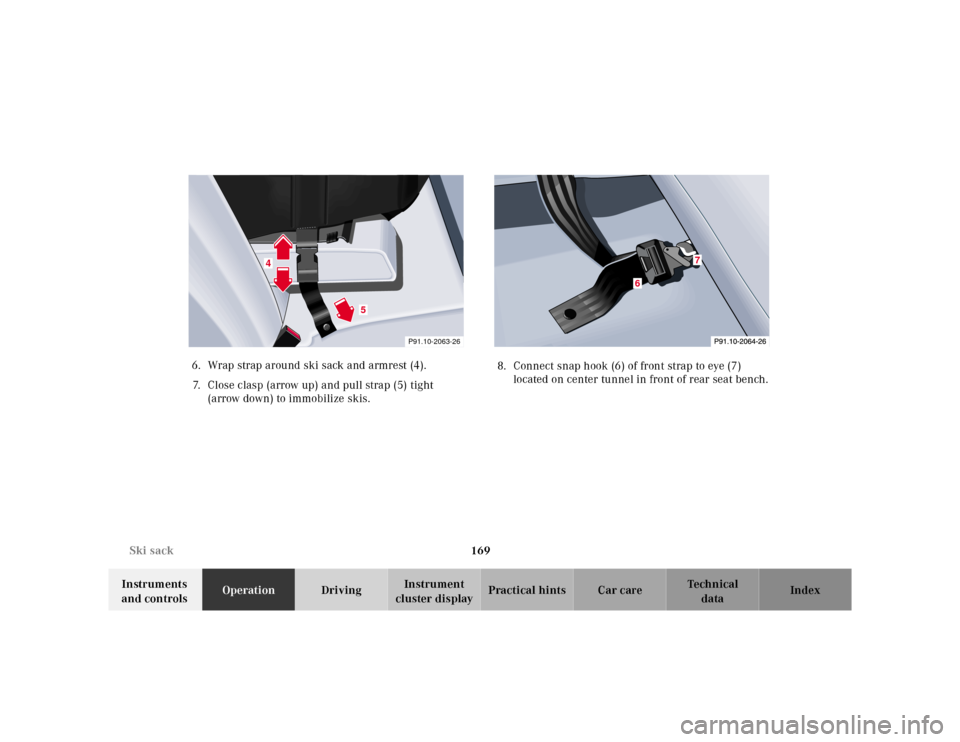
169 Ski sack
Te ch n ica l
data Instruments
and controlsOperationDrivingInstrument
cluster displayPractical hints Car care Index 6. Wrap strap around ski sack and armrest (4).
7. Close clasp (arrow up) and pull strap (5) tight
(arrow down) to immobilize skis.8. Connect snap hook (6) of front strap to eye (7)
located on center tunnel in front of rear seat bench.
P91.10-2063-26
4
5
6
7
Page 173 of 325
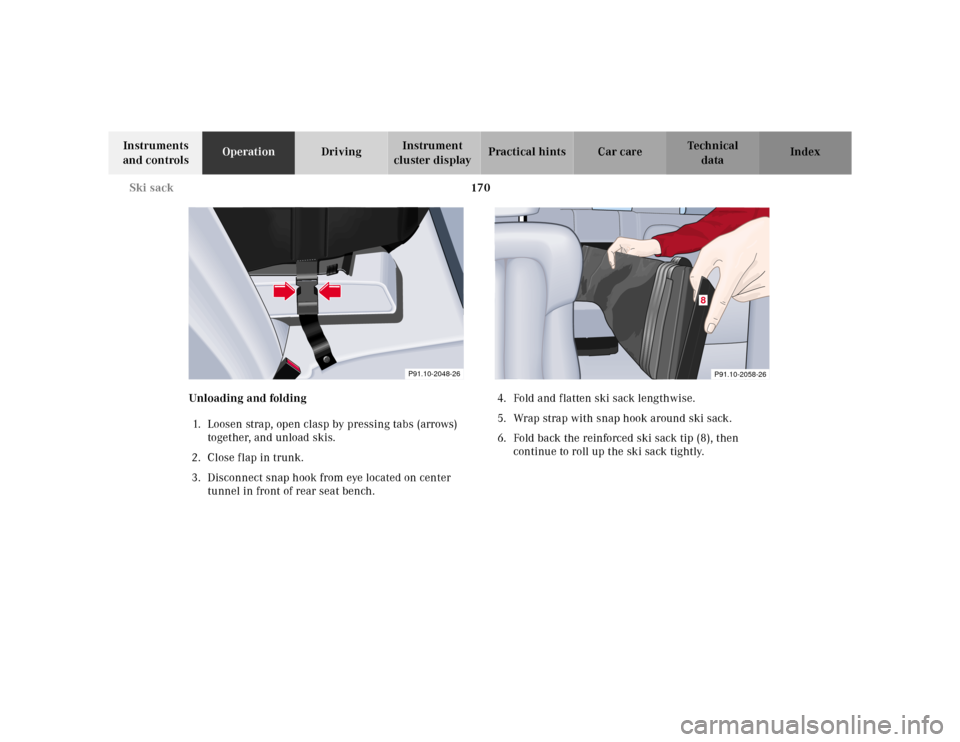
170 Ski sack
Te ch n ica l
data Instruments
and controlsOperationDrivingInstrument
cluster displayPractical hints Car care Index
Unloading and folding
1. Loosen strap, open clasp by pressing tabs (arrows)
together, and unload skis.
2. Close flap in trunk.
3. Disconnect snap hook from eye located on center
tunnel in front of rear seat bench.4. Fold and flatten ski sack lengthwise.
5. Wrap strap with snap hook around ski sack.
6. Fold back the reinforced ski sack tip (8), then
continue to roll up the ski sack tightly.
P91.10-2048-26
8
P91.10-2058-26
Page 174 of 325
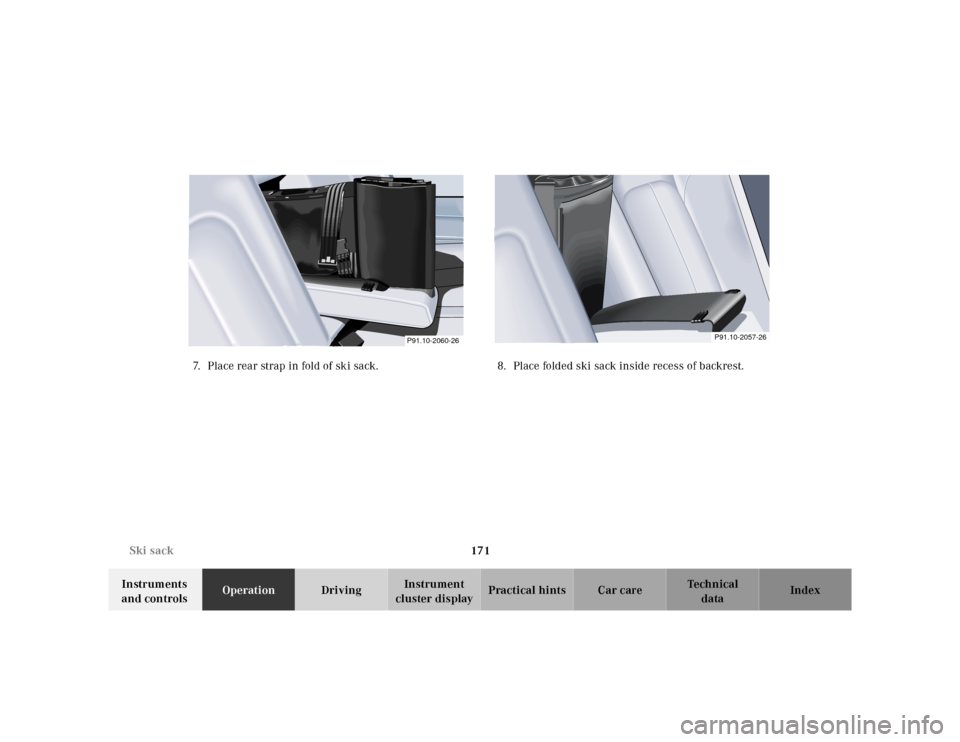
171 Ski sack
Te ch n ica l
data Instruments
and controlsOperationDrivingInstrument
cluster displayPractical hints Car care Index 7. Place rear strap in fold of ski sack. 8. Place folded ski sack inside recess of backrest.
P91.10-2060-26
P91.10-2057-26
Page 175 of 325
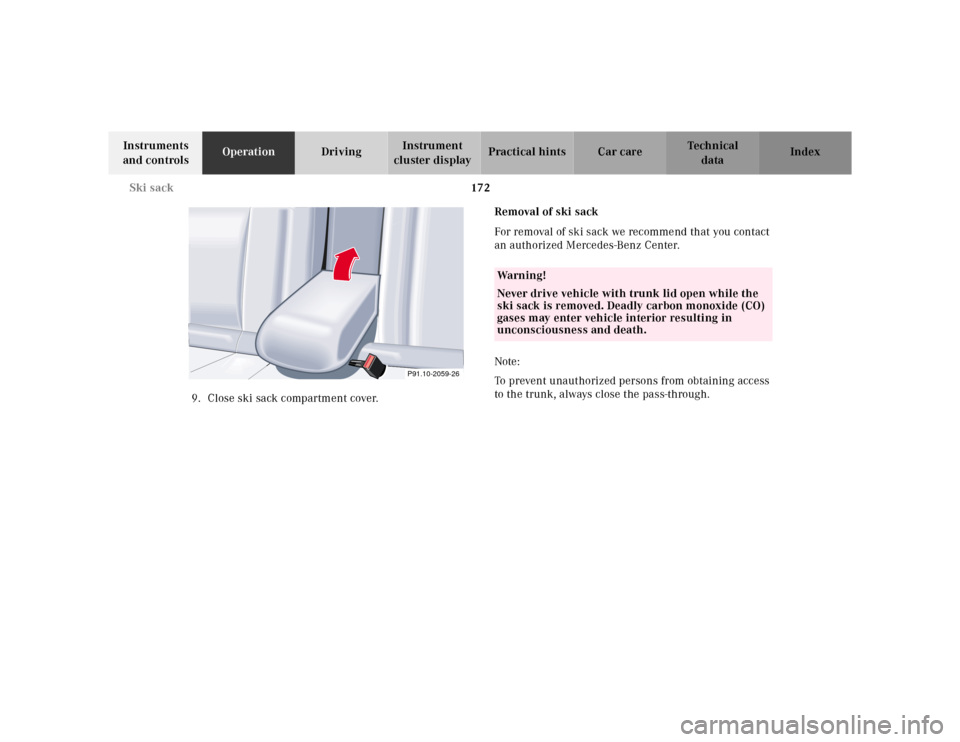
172 Ski sack
Te ch n ica l
data Instruments
and controlsOperationDrivingInstrument
cluster displayPractical hints Car care Index
9. Close ski sack compartment cover.Removal of ski sack
For removal of ski sack we recommend that you contact
an authorized Mercedes-Benz Center.
Note:
To prevent unauthorized persons from obtaining access
to the trunk, always close the pass-through.
P91.10-2059-26
Wa r n i n g !
Never drive vehicle with trunk lid open while the
ski sack is removed. Deadly carbon monoxide (CO)
gases may enter vehicle interior resulting in
unconsciousness and death.
Page 176 of 325
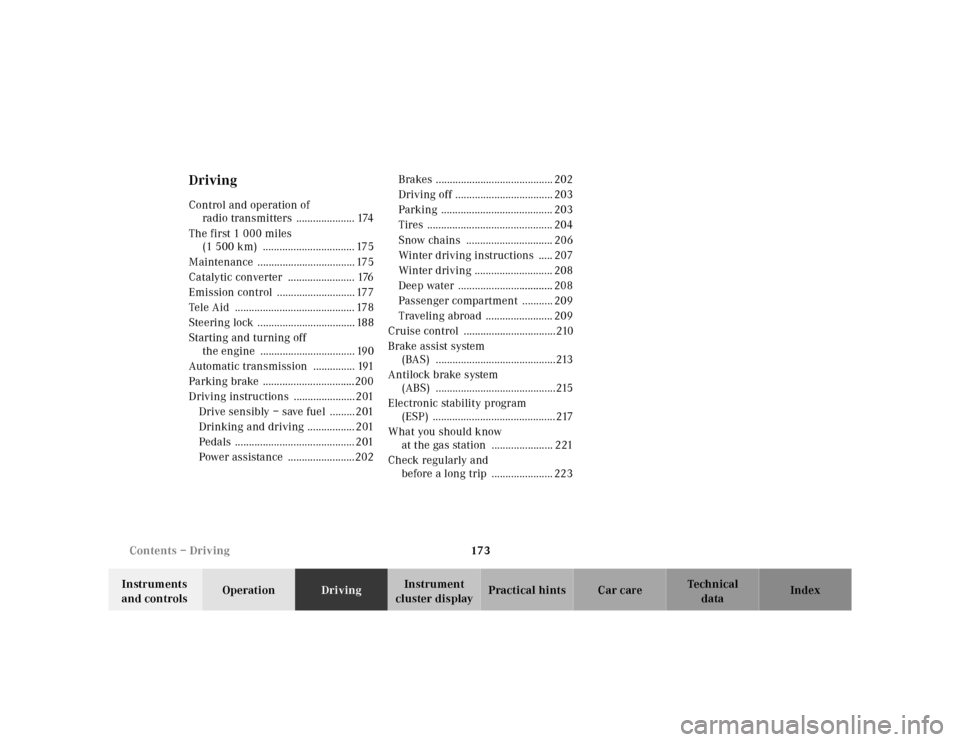
173 Contents – Driving
Te ch n ica l
data Instruments
and controlsOperationDrivingInstrument
cluster displayPractical hints Car care Index
DrivingControl and operation of
radio transmitters ..................... 174
The first 1 000 miles
(1 500 km) ................................. 175
Maintenance ................................... 175
Catalytic converter ........................ 176
Emission control ............................ 177
Tele Aid ........................................... 178
Steering lock ................................... 188
Starting and turning off
the engine .................................. 190
Automatic transmission ............... 191
Parking brake .................................200
Driving instructions ......................201
Drive sensibly – save fuel .........201
Drinking and driving ................. 201
Pedals ........................................... 201
Power assistance ........................202Brakes .......................................... 202
Driving off ................................... 203
Parking ........................................ 203
Tires ............................................. 204
Snow chains ............................... 206
Winter driving instructions ..... 207
Winter driving ............................ 208
Deep water .................................. 208
Passenger compartment ........... 209
Traveling abroad ........................ 209
Cruise control .................................210
Brake assist system
(BAS) ...........................................213
Antilock brake system
(ABS) ...........................................215
Electronic stability program
(ESP) ............................................217
What you should know
at the gas station ...................... 221
Check regularly and
before a long trip ...................... 223
Page 177 of 325
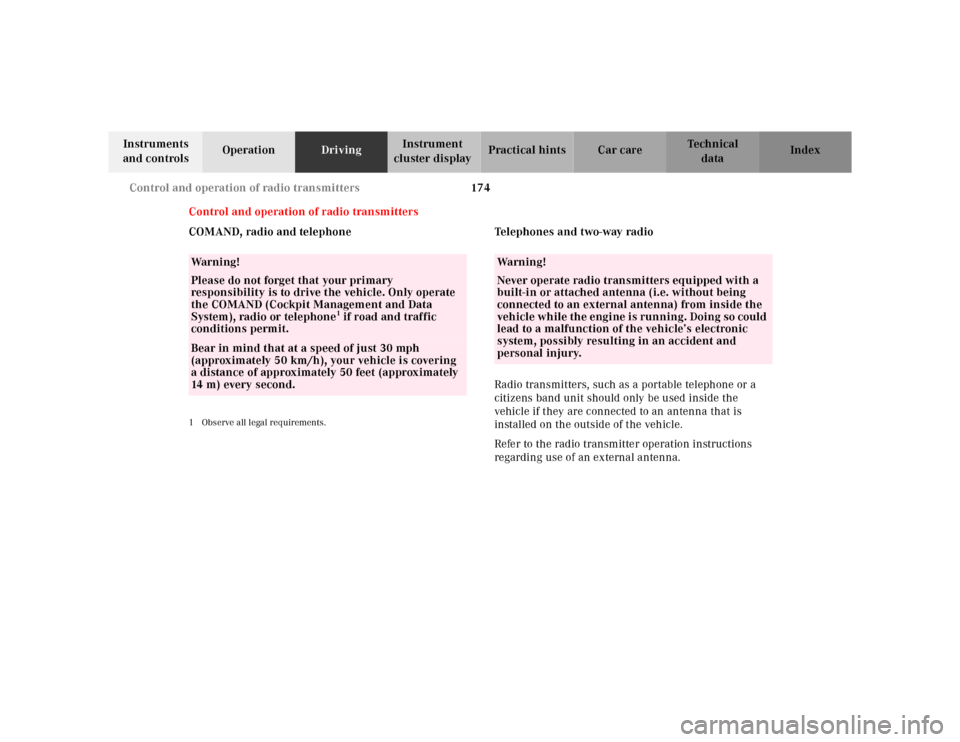
174 Control and operation of radio transmitters
Te ch n ica l
data Instruments
and controlsOperationDrivingInstrument
cluster displayPractical hints Car care Index
Control and operation of radio transmitters
COMAND, radio and telephone
1 Observe all legal requirements.
Telephones and two-way radio
Radio transmitters, such as a portable telephone or a
citizens band unit should only be used inside the
vehicle if they are connected to an antenna that is
installed on the outside of the vehicle.
Refer to the radio transmitter operation instructions
regarding use of an external antenna.
Wa r n i n g !
Please do not forget that your primary
responsibility is to drive the vehicle. Only operate
the COMAND (Cockpit Management and Data
System), radio or telephone
1 if road and traffic
conditions permit.
Bear in mind that at a speed of just 30 mph
(approximately 50 km/h), your vehicle is covering
a distance of approximately 50 feet (approximately
14 m ) e v e r y s e c o n d .
Wa r n i n g !
Never operate radio transmitters equipped with a
built-in or attached antenna (i.e. without being
connected to an external antenna) from inside the
vehicle while the engine is running. Doing so could
lead to a malfunction of the vehicle’s electronic
system, possibly resulting in an accident and
personal injury.
Page 178 of 325
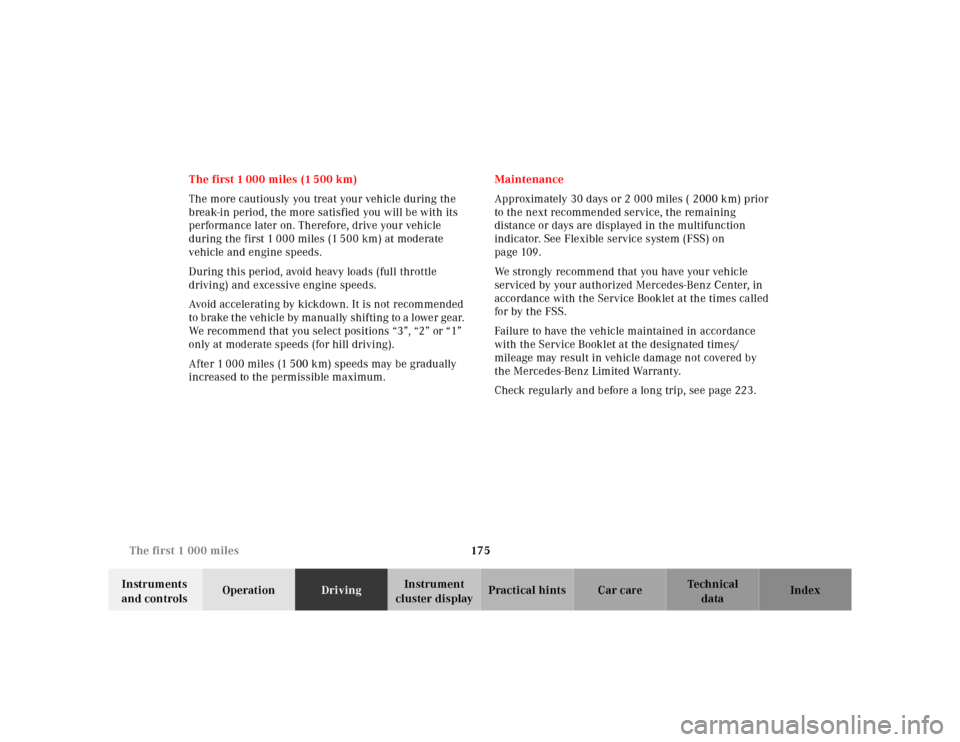
175 The first 1 000 miles
Te ch n ica l
data Instruments
and controlsOperationDrivingInstrument
cluster displayPractical hints Car care Index The first 1 000 miles (1 500 km)
The more cautiously you treat your vehicle during the
break-in period, the more satisfied you will be with its
performance later on. Therefore, drive your vehicle
during the first 1 000 miles (1 500 km) at moderate
vehicle and engine speeds.
During this period, avoid heavy loads (full throttle
driving) and excessive engine speeds.
Avoid accelerating by kickdown. It is not recommended
to brake the vehicle by manually shifting to a lower gear.
We recommend that you select positions “3”, “2” or “1”
only at moderate speeds (for hill driving).
After 1 000 miles (1 500 km) speeds may be gradually
increased to the permissible maximum.Maintenance
Approximately 30 days or 2 000 miles ( 2000 km) prior
to the next recommended service, the remaining
distance or days are displayed in the multifunction
indicator. See Flexible service system (FSS) on
page 109.
We strongly recommend that you have your vehicle
serviced by your authorized Mercedes-Benz Center, in
accordance with the Service Booklet at the times called
for by the FSS.
Failure to have the vehicle maintained in accordance
with the Service Booklet at the designated times/
mileage may result in vehicle damage not covered by
the Mercedes-Benz Limited Warranty.
Check regularly and before a long trip, see page 223.
Page 179 of 325
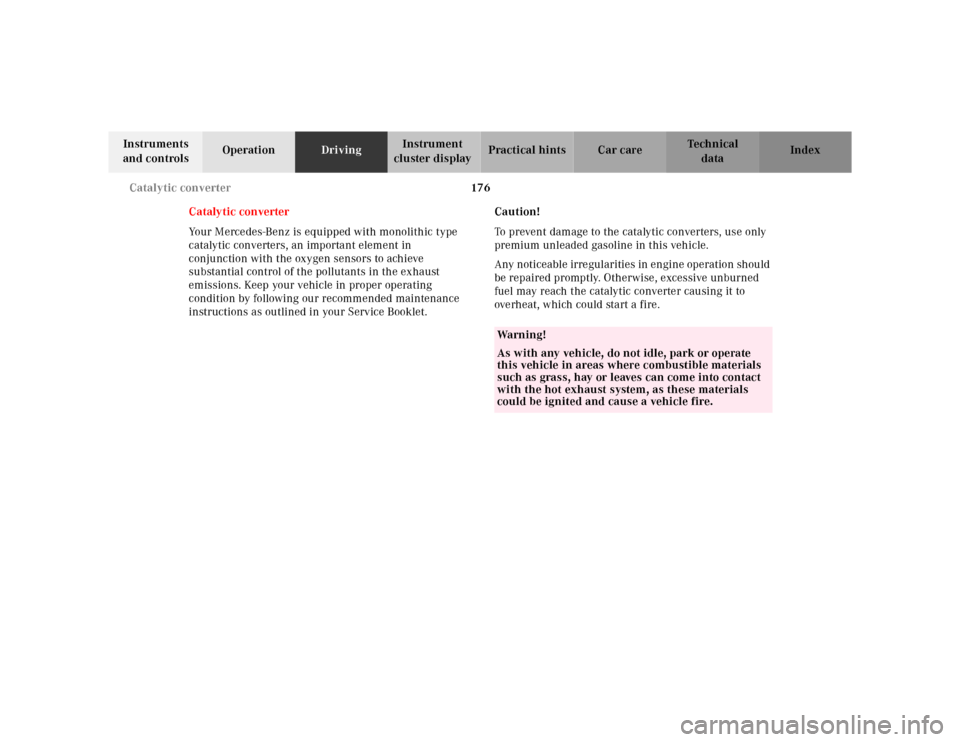
176 Catalytic converter
Te ch n ica l
data Instruments
and controlsOperationDrivingInstrument
cluster displayPractical hints Car care Index
Catalytic converter
Your Mercedes-Benz is equipped with monolithic type
catalytic converters, an important element in
conjunction with the oxygen sensors to achieve
substantial control of the pollutants in the exhaust
emissions. Keep your vehicle in proper operating
condition by following our recommended maintenance
instructions as outlined in your Service Booklet.Caution!
To prevent damage to the catalytic converters, use only
premium unleaded gasoline in this vehicle.
Any noticeable irregularities in engine operation should
be repaired promptly. Otherwise, excessive unburned
fuel may reach the catalytic converter causing it to
overheat, which could start a fire.
Wa r n i n g !
As with any vehicle, do not idle, park or operate
this vehicle in areas where combustible materials
such as grass, hay or leaves can come into contact
with the hot exhaust system, as these materials
could be ignited and cause a vehicle fire.
Page 180 of 325

177 Emission control
Te ch n ica l
data Instruments
and controlsOperationDrivingInstrument
cluster displayPractical hints Car care Index Emission control
Certain systems of the engine serve to keep the toxic
components of the exhaust gases within permissible
limits required by law.
These systems, of course, will function properly only
when maintained strictly according to factory
specifications. Any adjustments on the engine should,
therefore, be carried out only by qualified Mercedes-
Benz authorized center technicians. Engine adjustments
should not be altered in any way. Moreover, the
specified service jobs must be carried out regularly
according to Mercedes-Benz servicing requirements.
For details refer to the Service Booklet.
Wa r n i n g !
Inhalation of exhaust gas is hazardous to your
health. All exhaust gas contains carbon monoxide,
and inhaling it can cause unconsciousness and
lead to death.Do not run the engine in confined areas (such as a
garage) which are not properly ventilated. If you
think that exhaust gas fumes are entering the
vehicle while driving, have the cause determined
and corrected immediately. If you must drive under
these conditions, drive only with at least one
window fully open.